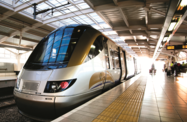Japan has joined France, Germany, China and South Korea as a prospective investor in South Africa’s proposed high-speed rail system, which, once built, will link Johannesburg and Durban on the east coast. However, while there is no doubt about the attractiveness of the multi-billion dollar large-scale infrastructure project, questions remain about whether the project will prove profitable for private sector partners unless it is subsidised by the South African government.
The link marks the first phase of an $18bn rail project, which is expected to herald a new era for South Africa’s transport sector and play a key part in easing pressure on the roads. Japan signalled its commitment to invest in the rail network during a visit from a South African delegation in mid-January.
A prefeasibility study released in January concluded that a very-high-speed (VHS) rail link connecting the two cities over a 600-km distance could expect to carry around 17,000 passengers daily when it comes into operation in 2025, rising to between 33,000 and 38,000 per day by 2050. The link will also be able to shift up to 4.2m tonnes of freight annually.
Yoshimasa Sakon, the technology headquarters senior manager of the Japan International Consultants for Transportation Company, which prepared the study, said each passenger train would be able to transport 600 people at a speed of 300 km per hour (kph). He added that freight trains would transport 48 standard containers at 160 kph.
The proposal to build the Johannesburg-Durban VHS line was incorporated into the Department of Transport’s draft master plan for a high-speed rail system some months after the concept was first floated in early 2010.
While South Africa will need overseas technology and expertise to roll out the rail initiative, officials have said any partnership would have to include an agreement for technology and skills transfer, investment, high local input and job generation. South Africa will be hoping that a gradual reduction of overseas involvement paves the way for the country to begin making economic gains earlier on in the next phase of the project rather than only reaping rewards once the new routes are up and running.
Alongside Japan, firms from China, France, Germany and South Korea have also signalled their interest in the rail project. South Africa will be aware that China, which is currently working to develop its own VHS network, could offer favourable cost considerations, given Beijing’s well-documented interest in breaking into African markets. France’s Alstom, which has long expressed an interest in the initiative and holds some 60% of the global VHS rail market, is certainly another strong contender.
However, Philippe Roch, the director of Alstom Transport South Africa, last year queried whether the Johannesburg to Durban route would be profitable without government backing. His doubts are echoed by others who have pointed out that the Gautrain, South Africa’s only current high-speed rail line, which links Johannesburg and Pretoria, is subsidised by the state, partly due to lower than expected passenger figures. The train needs to carry 110,000 passengers per day to break even, but carries some 38,000-40,000, local media said in August. The government is subsidising the rail at a cost of R300m ($33.5m) per year.
Despite question marks around funding issues, there is widespread agreement that the proposed rail link could play a major role in easing congestion and reducing wear on South Africa’s roads, pushing up levels of passenger travel and freight transported by train, which currently stand at just 7%.
While freight congestion has long been a concern for South Africa, particularly on its rail networks, the government will also be hoping that moving people onto trains and off the roads helps reduce traffic accidents. According to data issued by the Transport Ministry in mid-January, the cost of fatal road accidents to the national economy in 2012 was around $35bn, or 10% of GDP. During the five-week-long summer holiday break, almost 1500 South Africans were killed on the roads.
In a statement made after the break, Transport Minister Ben Martins said the cost of accidents flowed through the economy. “Road traffic fatalities are among the main causes of death in South Africa,” Martins said. “The economic ramifications include the increase in the social development and health budgets spent.”
Debates about whether the proposed rail link will prove profitable could attract greater interest as the project gains pace. However, its supporters will be keen to shift the spotlight onto the value added that building a VHS rail connection between the country’s commercial heart and one of its biggest ports brings to the South African economy.

